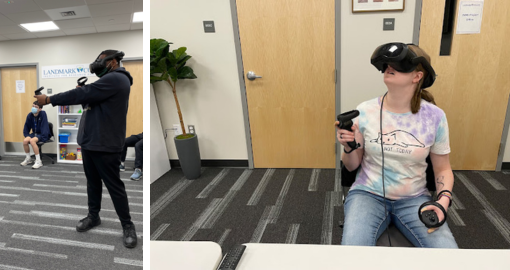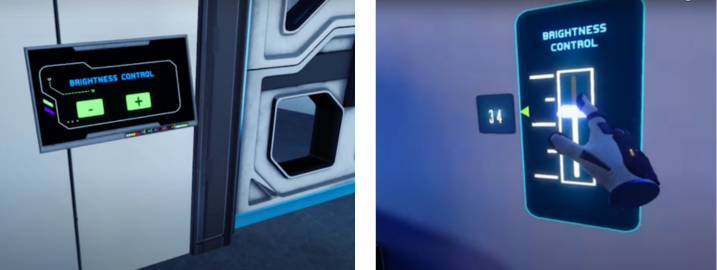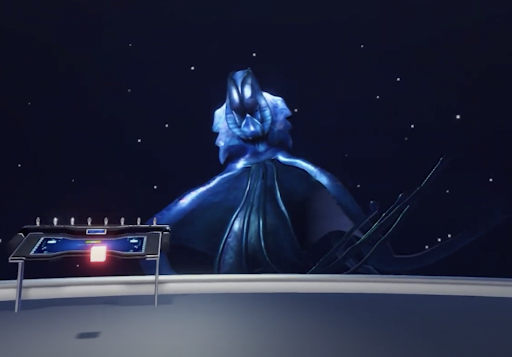UniVRsal Access: Broadening Participation in Informal STEM Learning for Autistic Learners and Others through Virtual Reality
by Teon Edwards
Key Ideas
Successful collaboration requires scaffolding the process of working together, such as by making the choices, taking the time, and finding the tools that enable each team member to engage in a manner that works and is comfortable for them. For the UniVRsal Access project, the co-design process and especially our neurodivergent team members shaped the development and research of the STEM-based VR game Europa Prime in unexpected, exciting, powerful, and occasionally challenging ways. What brings stakeholders to a project are not the only things stakeholders bring to that project.
Background
The project UniVRsal Access: Broadening Participation in Informal STEM Learning for Autistic Learners and Others Through Virtual Reality (NSF grant DRL-2005447) was developed (a) to design, develop, and research a VR STEM-learning game for use by a broad audience that includes learners with autism and other sensory, attention, and social (SAS) differences and (b) to provide VR developers and learning technology designers and researchers with additional knowledge about the affordances of VR for STEM learning and design choices that consider autistic learners and those with other SAS differences.
The partners on this project are the Educational Gaming Environments group (EdGE) at TERC, Landmark College, MXTreality, and Knology, as well as various informal science (ISE) organizations, including the Museum of Science, Boston. EdGE and Landmark College – a postsecondary institute exclusively for students who learn differently, including students with a learning disability (such as dyslexia), ADHD, autism, or executive function challenges – worked together on the game co-design process. EdGE and MXTreality, a development company that creates VR “tech for good,” are developing the actual VR game. Knology, a collective of scientists, writers, and educators dedicated to studying and untangling complex social issues, is serving as the project’s external evaluator. And the ISE partners are hosting the research and assisting with recruitment of neurodivergent participants.
The goal of UniVRsal Access is to broaden participation in informal STEM learning by using VR to create accessible, immersive science learning adventures that are designed with and for neurodivergent learners. “Broadening” means expanding to encompass more; “empowering” means transferring the authority or power to do something, as well as making (someone) stronger and more confident. For UniVRsal Access, broadening is part of the goal, involving neurodivergent learners in the process and designing for a broad audience that includes neurodivergent learners. And empowering takes this further, involving choices, attitudes, and scaffolds, many related to supporting a wide range of communication needs and preferences, but others related to shifts in control.
Story of the Partnership
The partnership between Landmark College and EdGE at TERC involved two intensive years of co-designing a STEM-based VR game called Europa Prime with the goal of engaging a broad audience, including neurodivergent players. The co-design team consisted of eleven members who identify as neurodivergent learners and three who identify as neurotypical learners. Ten were undergraduate interns from Landmark College, involved for a semester, a year, or two years. Four were education developers and researchers from EdGE. In our view, co-design is designing with, not just for, target communities and stakeholders. It’s about focusing on stakeholders’ needs and interests by having them be full, authentic members of the team who not only inform the process but who are also empowered to truly shape it.
— Becky Scheff (Co-Design Team Member, Landmark Intern)
Co-design serves its stakeholders both through the final products – in this case, the STEM-based VR game Europa Prime – and through the process itself. The acts of working on a team; learning about game design and education research; being involved with and conducting research; designing the game; and building other social and professional skills (such as clear communication across barriers) allows a reciprocal learning experience for everyone involved.
— Katherine H. (Co-Design Team Member, Landmark Intern)

Photo credit: Teon Edwards
Some of the Landmark co-design team members on the rare occasions, during COVID-19 restrictions, where they got to explore virtual reality.
Europa Prime has been shaped by the co-design process in ways not originally envisioned, which was both wonderful and scary.
— Teon E. (Co-Design Team Member, EdGE at TERC)
The specific goals of the co-design team were to design pieces of a game that were fun, involved interesting STEM content and skills, and addressed SAS differences, as well as were engaging for the team members involved.
— Gerald B. (Co-Design Team Member, Landmark Intern)

Photo credit: MXTreality
Early VR builds with functional in-game brightness controls, empowering the player to make the environment comfortable without needing to go to an options or settings menu.
The UniVRsal Access co-design process involved weekly all-team meetings, weekly pair or small group meetings, a limited (because of COVID) number of in-person interactions, and a wide variety of between-meeting design and research tasks. These meetings and tasks were carefully crafted to make sure everyone had the tools, means, and opportunities to be “heard” – even when verbal and/or written communication was not preferred, as was the case for several team members. The extensive involvement of neurodivergent team members highlighted the need to not just involve stakeholders in the process, but also to learn what the team members’ communication and executive function needs are, to design the work process to meet those needs, and to check in on a regular basis to ensure that the process is working well for each team member.
— Daniel L. (Co-Design Team Member, Landmark Intern)
Week-by-week and semester-by-semester, team members worked together on different elements of the design. We pursued both team-wide objectives and individual passions to create character designs, backstory elements, individual puzzles, user interface elements, iterative artwork feedback, and research instrument design. In parallel, EdGE designers worked to guide the process without oversteering it, to meld and interweave the different ideas together, to structure the research, and to keep the project goals in sight.
Very early in the co-design process, two neurodivergent team members offered a new interpretation of designing for sensory differences, shifting to the broader idea of exploring sensory tolerances and feelings of being overwhelmed. Eventually, this grew into a design feature that brought sensory differences into the game explicitly. The game design already included sensory-related design choices (such as color and scene complexity choices) and already offered integrated user controls (such as noise and brightness controls). With the input from neurodivergent team members, however, the game narrative now also has sensory differences as part of the story, presenting an in-game challenge for every player – neurodivergent and (so-called) neurotypical alike – to confront. This is just one of many examples of how co-design shaped the game in unexpected and potentially powerful ways.
— Ibrahim Dahlstrom-Hakki. (Co-Design Team Member, EdGE at TERC)

Photo Credit: MXTreality
VR design of a Minos, the main lifeform in the game, attempting to communicate with the player.
UniVRsal Access and the EdGE-Landmark partnership has not lacked challenges. Because it was funded during the summer of 2020, the entirety of the project has been conducted under COVID. This restricted the team to mostly remote-only interactions and very limited opportunities to get anyone – co-design team members and research participants – into VR headsets. We had to figure out how to collaborate, share, and conduct remote design meetings with members who didn’t know one another and who had very different communication styles and abilities. We, like so many others, figured out the tools and approaches that worked for us, shifting and adjusting them to fit the needs and preferences of members over time. For our team, this included:

Photo credit: MXTreality and UA Co-Design Team
Example Miro Board, where the co-design team provided feedback for social bots.
With no willingness or ability to get people into headsets due to the pandemic, we shifted our early research questions online. We used pairwise images of different brightnesses, hues (colors), and amounts of clutter to answer questions about the preferences of (by self-report) neurodivergent and neurotypical participants, building to a later round of research conducted in VR, looking at brightness, clutter, and noise. While far from ideal, this still helped us address design research questions and make progress toward our longer-term goals.
With no willingness or ability to get people into headsets due to the pandemic, we shifted our early research questions online. We used pairwise images of different brightnesses, hues (colors), and amounts of clutter to answer questions about the preferences of (by self-report) neurodivergent and neurotypical participants, building to a later round of research conducted in VR, looking at brightness, clutter, and noise. While far from ideal, this still helped us address design research questions and make progress toward our longer-term goals.

Example pairwise images, used as part of a research study conducted during COVID restrictions, exploring neurodivergent and (so-called) neurotypical learners’ preferences in terms of brightness, color, and amount of clutter.
By embracing co-design and truly empowering the team to shape things, we created challenges for ourselves. The original premise of the game had the player alone on an abandoned space station of Europa, an icy moon of Jupiter, faced with a mystery to solve. Aspects of this premise stayed the same, such as the player being alone on the space station; however, through co-design, the mystery, as originally envisioned, was allowed to shift. This resulted in additional work to make sure the new story ideas came together and the new story arc felt cohesive. Co-design team members were encouraged to work on ideas even when the connections to neurodiversity were unclear. This encouragement was vital to member agency and resulted in some wonderful ideas, but which also broadened and shifted what was being designed. Sometimes this meant less attention on a sensory or attention-related element than originally envisioned; other times it meant a rich idea that added to the game but might be less connectable to the research. These are challenges of positive opportunity, but they are still challenges.
Lessons Learned
The Landmark-EdGE co-design partnership has deepened the team’s expectations and hopes for what collaboration can be and what collaboration may entail.
One lesson involves having stakeholders help shape a project from its inception. When the co-design process began, the UniVRsal Access project and its Europa Prime game were not blank slates. As part of a pilot project, a basic premise for the game had been established and a prototype developed and tested. Then, during proposal writing, areas where it seemed vital to have solid, extensive design input from neurodivergent learners, such as user interfaces, puzzles, and supports for sensory, attention, and social differences, had been identified. Landmark was part of crafting the proposal, but no interns were involved. In the future, whenever we can figure out how to fund it, we want collaboration and co-design, not just an agreement on a partnership and crafting of a proposal, to start as early as possible.
— Teon E. (Co-Design Team Member, EdGE at TERC)
The second lesson relates to understanding that it takes a great deal of time and planning to create respectful and effective co-design procedures, but they are well worth the effort. The most impactful elements of this project, in terms of how we will center partnerships in our future research and design efforts, are related to expectations about the amount of work required to support a successful collaboration, and how we should treat team members.
— Teon E. (Co-Design Team Member, EdGE at TERC)
The final lesson relates to not constraining the roles of stakeholders, but instead honoring all that team members bring to the co-design process. It should go without saying, but too often it does not, that people are not unidimensional. In the case of UniVRsal Access, the stakeholders were chosen because they were neurodivergent learners. Landmark College is a partner on the project because it exclusively serves students who learn differently. And the interns were on the co-design team because they are neurodivergent and could bring that vital perspective and expertise to the project. However, the roles of the neurodivergent members of the co-design team were not and could not be constrained to what they brought as neurodivergent learners. They were bringing many aspects of themselves, and the project and everyone involved needed to embrace and honor that, at exactly the same time we were valuing neurodiversity.
